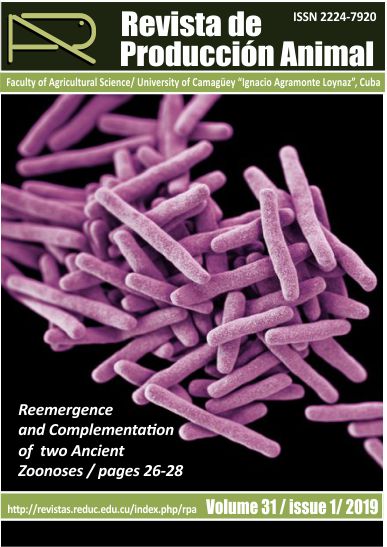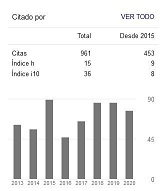Analysis of Secondary Metabolites from Leaf Powder of Origanum vulgare and Ficus pandurata
Resumen
Background: Additives from plants are considered an alternative to antibiotics due to their safety and null residual effects. The secondary metabolites in the leaf powder of Origanum vulgare (oregano) and Ficus pandurata were analyzed.
Methods: The experiment was done at the Center for Studies of Applied Chemistry, at the Faculty of Technical Sciences, University of Granma, Cuba. The leaves from both plants were collected, taking into account the variations in sizes and structure. The organic compounds were determined in the alcoholic and aqueous extracts due to their solubility in these solvents. The crossing technique was used for qualification of secondary metabolites.
Results: The use of tannin-rich powders decreased the incidence of diarrhea, and benefited production, due to their anti-inflammatory and astringent properties, and vasoconstrictive effects. It also showed antioxidant and anti bacterial activity against strains of enterobacteria. The detected cumarins acted as powerful anticoagulants and bactericides, whereas the flavonoids increased nutrient digestibility, the organic function of the body, and the antioxidant capacity. Besides, they modified the synthesis of eicosanoids. The anthocyanidins present in the alcoholic extract of both medicinal plants had therapeutic effects linked to antioxidant and antidiabetic properties, like lipid control, insulin secretion, and vasoprotective effects.
Conclusions: Based on analysis of secondary metabolites from leaf powder of Origanum vulgare and Ficus pandurata, further study is recommended to fully determine the usefulness of these plants as phyto-chemical additives in the diet of animals
Descargas
Citas
KHEDR, A. I.; ALLAM, A. E.; NAFADY, A. M.; AHMAD, A. S. y RAMADAN, M. A. (2015). Phytochemical and Biologi-cal Screening of the Leaves of Ficus pandurata Hance. Cultivated in Egypt. Journal of Pharmacognosy and Phytochemistry, 4 (1), 50-54.
MADUREIRA, A. M.; ASCENSO, J. R.; VALDEIRA, l.; DUARTE, A.; FRADE, J. P.; FREITAS, G. y FERREIRA, M.G.U. (2003). Evaluation of the Antiviral and Antimicrobial Activities of Triterpenes Isolated from Euphorbia sege-talis. Nat Prod Res., 17 (5), 375-80.
MARTÍNEZ, Y.; SOTO, F.; ALMEIDA, M.; Hermosilla, R. y MARTÍNEZ, O. (2012). Metabolitos secundarios y activid-ad antibacteriana in vitro de extractos de hojas de Anacardium occidentale L. (marañón). Revista Cubana de Plantas Medicinales, 17 (4), 320-329.
MIRANDA, M. y CUÉLLAR, A. (2001). Farmacognosia y Productos Naturales. La Habana, Cuba: Editorial Félix Varela.
MORÓN, F. J. (2011). ¿Son importantes las plantas medicinales en la actualidad? Rev. Cubana Plant. Med., 15 (2), 1-2.
Los autores de los artículos publicados en RPA retienen los derechos de autor de su trabajo, de marca y patente, y también sobre cualquier proceso o procedimiento descrito en el artículo, así como a compartir, copiar, distribuir, ejecutar y comunicar públicamente el artículo publicado en la RPA o cualquier parte de aquel siempre que indiquen la fuente de publicación (autores del trabajo, revista, volumen, número y fecha), pero están de acuerdo en que la revista publique los trabajos bajo una licencia Creative Commons.
![]() Licencia Attribution-NonCommercial 4.0 International (CC BY-NC 4.0)
Licencia Attribution-NonCommercial 4.0 International (CC BY-NC 4.0)






































